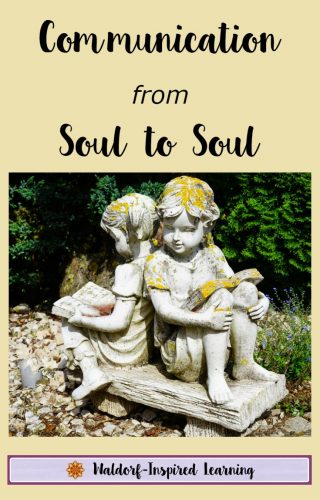“Communication must be from soul to soul,” said Rudolf Steiner.
And the medium? Stories! Stories that speak to our hearts, told in a way that “evokes a kind of silent thrilled awe.”
Read on for tips on storytelling in Waldorf education.
 Stories and history really form the scaffolding for the Waldorf curriculum and Steiner spoke of finding “the right material for telling and retelling.” He said to look for stories that have a “free and narrative style.”
Stories and history really form the scaffolding for the Waldorf curriculum and Steiner spoke of finding “the right material for telling and retelling.” He said to look for stories that have a “free and narrative style.”
Since the Waldorf curriculum is really delivered through storytelling and narrative presentations, the importance of finding good stories is clear. In Waldorf-inspired learning, we do not explain but rather tell stories to engage the whole child’s being so that knowledge is passed on through narrative rather than direct instruction.
As homeschoolers, we are in a great position to strive for this: “Let your influence arise out of your close intimacy with the children…not through artificial sensationalism.”
Storytelling is at the heart of Waldorf education. The literary arts sit at the top of a five-pointed star that I call the Lively Arts. We can tell stories of our own childhoods at bedtime, read stories of life in other cultures and times to study ancient history, and paint pictures from fairy tales. But the most important criteria is that the stories are beautiful and speak to us personally.
Those new to Waldorf methods often ask: “must I memorize and tell by heart all the stories?” No, this is not a mandatory requirement nor a rite of passage!
I recommend reading the story yourself ahead of presenting it to your child or children so that you connect to the emotion behind it. You might also memorize the opening and closing so that you can connect with your listeners and create a storytelling atmosphere. But then reading the story aloud is perfectly fine. At home, we generally have a smaller group than in a classroom and we can hold the energy with our own connection to the stories we read.
Believe it or not, here is the brief list of types of stories that Steiner provided to the teachers in the first Waldorf school during their two-week training:
Grade 1: Fairy Tales
Grade 2: Animal Fables and Stories of How Animals Live in Real Live
Grade 3: Biblical Stories as part of General History
Grade 4: Scenes from Ancient History
Grade 5: Scenes from Medieval History
Grade 6: Scenes from Modern History
Grade 7: Stories of Various Races and Tribes (Indian, Chinese, American)
Grade 8: Knowledge of the Peoples of the Earth
As you can see, you have much leeway here for finding stories.
So search out the stories you love and share them with your children!
You can find more ideas and inspiration in my article
The Seven Lively Arts.


This all needs to be shouted from the mountain tops!!
THANK YOU! Why is it we have a tendency to so complicate things!?! I woke up thinking that just like the storytellers in days of old, we are the “keepers of the flame.”
Is it possible for you to put a WordPress “like” button on your posts? (I see the facebook one.) I have my blog set up where if I like a post it automatically puts a link on my sidebar. I know Andrea’s blog is set up like this too. Anyway, just curious if that was easy to do.
Great idea. I will figure that out! Thank you, my friend.